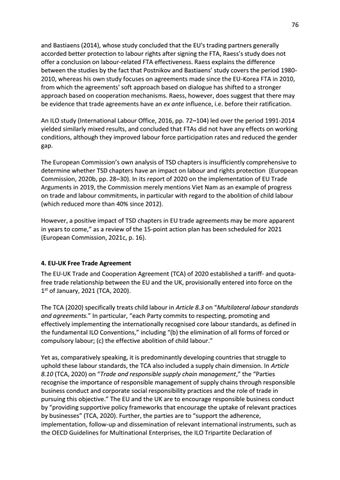76 and Bastiaens (2014), whose study concluded that the EU's trading partners generally accorded better protection to labour rights after signing the FTA, Raess’s study does not offer a conclusion on labour-related FTA effectiveness. Raess explains the difference between the studies by the fact that Postnikov and Bastiaens’ study covers the period 19802010, whereas his own study focuses on agreements made since the EU-Korea FTA in 2010, from which the agreements' soft approach based on dialogue has shifted to a stronger approach based on cooperation mechanisms. Raess, however, does suggest that there may be evidence that trade agreements have an ex ante influence, i.e. before their ratification. An ILO study (International Labour Office, 2016, pp. 72–104) led over the period 1991-2014 yielded similarly mixed results, and concluded that FTAs did not have any effects on working conditions, although they improved labour force participation rates and reduced the gender gap. The European Commission’s own analysis of TSD chapters is insufficiently comprehensive to determine whether TSD chapters have an impact on labour and rights protection (European Commission, 2020b, pp. 28–30). In its report of 2020 on the implementation of EU Trade Arguments in 2019, the Commission merely mentions Viet Nam as an example of progress on trade and labour commitments, in particular with regard to the abolition of child labour (which reduced more than 40% since 2012). However, a positive impact of TSD chapters in EU trade agreements may be more apparent in years to come,” as a review of the 15-point action plan has been scheduled for 2021 (European Commission, 2021c, p. 16).
4. EU-UK Free Trade Agreement The EU-UK Trade and Cooperation Agreement (TCA) of 2020 established a tariff- and quotafree trade relationship between the EU and the UK, provisionally entered into force on the 1st of January, 2021 (TCA, 2020). The TCA (2020) specifically treats child labour in Article 8.3 on “Multilateral labour standards and agreements.” In particular, “each Party commits to respecting, promoting and effectively implementing the internationally recognised core labour standards, as defined in the fundamental ILO Conventions,” including “(b) the elimination of all forms of forced or compulsory labour; (c) the effective abolition of child labour.” Yet as, comparatively speaking, it is predominantly developing countries that struggle to uphold these labour standards, the TCA also included a supply chain dimension. In Article 8.10 (TCA, 2020) on “Trade and responsible supply chain management,” the “Parties recognise the importance of responsible management of supply chains through responsible business conduct and corporate social responsibility practices and the role of trade in pursuing this objective.” The EU and the UK are to encourage responsible business conduct by “providing supportive policy frameworks that encourage the uptake of relevant practices by businesses” (TCA, 2020). Further, the parties are to “support the adherence, implementation, follow-up and dissemination of relevant international instruments, such as the OECD Guidelines for Multinational Enterprises, the ILO Tripartite Declaration of













